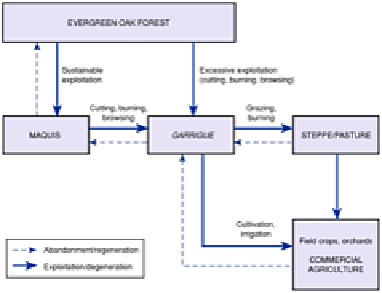Environmental Engineering Reference
In-Depth Information
vegetation has been, first, to reduce the natural resource base on which subsequent
peoples could depend; second, to introduce, whether deliberately or inadvertently, species
foreign to the area (olive, orange, cotton, sugar cane and many other species), and thirdly
to accelerate natural rates of erosion by deforestation, grazing, burning and cultivation.
The effect of browsing by goats is illustrated in Figure 26.8. It is possible to look at a
holly oak (
Quercus coccifera
) and estimate how severely it is browsed. The most intense
is where the tree is bitten into a cushion shape; less intense browsing is shown
successively by columns, thickets and 'got-aways'. Thereafter the shrub grows above the
height of browsing, except where goats can climb into the tree to produce a goat pollard.
The shrubby and steppe-like vegetation which is so characteristic of today's wild
landscapes of the Mediterranean region has traditionally been viewed by biogeographers
such as Polunin, Huxley, Eyre and Thirgood as a result of human pressures superimposed
upon climatic trends. The effects of these human impacts, and their relationships with
both degenerative and regenerative trends in vegetation, are shown in Figure 26.9. The
Figure 26.8
The effect of browsing on shrubs and trees.
Source: After Rackham and Moody (1996).
Figure 26.9
The ecological dynamics of Mediterranean plant
communities.


